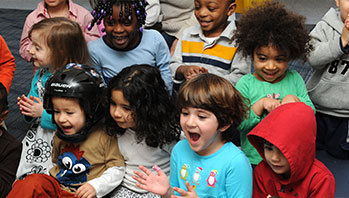- name cards
MA Standards:
English Language Arts/Speaking and Listening/SL.PK.MA.1a Observe and use appropriate ways of interacting in a group (e.g., taking turns in talking, listening to peers, waiting to speak until another person is finished talking, asking questions and waiting for an answer, gaining the floor in appropriate ways).
English Language Arts/Foundational Skills/RF.PK.MA.2 With guidance and support, demonstrate understanding of spoken words, syllables, and sounds (phonemes).
Head Start Outcomes:
Social Emotional Development/Self-Regulation Follows simple rules, routines, and directions.
Language Development/Receptive Language Attends to language during conversations, songs, stories, or other learning experiences.
Literacy Knowledge/Phonological Awareness Identifies and discriminates between separate syllables in words.
PreK Learning Guidelines:
English Language Arts/Language 1 Observe and use appropriate ways of interacting in a group (taking turns in talking; listening to peers; waiting until someone is finished; asking questions and waiting for an answer; gaining the floor in appropriate ways).
English Language Arts/Reading and Literature 12 Listen to, recite, sing, and dramatize a variety of age-appropriate literature.
English Language Arts/Reading and Literature 8 Listen to, identify, and manipulate language sounds to develop auditory discrimination and phonemic awareness.
Greeting Song: “Who’s on the Hill?” #3

© Commonwealth of Massachusetts, Department of Early Education and Care (Jennifer Waddell photographer). All rights reserved.
ELA Focus Skills: Name Recognition, Phonological Awareness (Rhythm, Rhyme, and Repetition)
Gather children together and tell them they will recite “Who’s on the Hill?” Tell children that today you are going to say a child’s name and clap out the parts of his or her name. Recite the verse, naming a child and clapping the syllables in the name, for example, Wil-lie (clap twice) or Sa-man-tha (clap three times). Have children clap along as they chant the child’s name three times and cheer “Hooray!”
Continue until each child has been recognized.
Who’s on the Hill?
Up on that hill,
Who do you see?
I see <child’s name>
Looking at me.
<child’s name>, <child’s name>, <child’s name>! Hooray!
Adaptation: For very young children, chant one line at a time; then ask them to repeat it.
